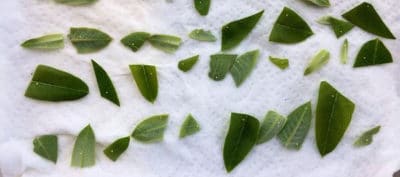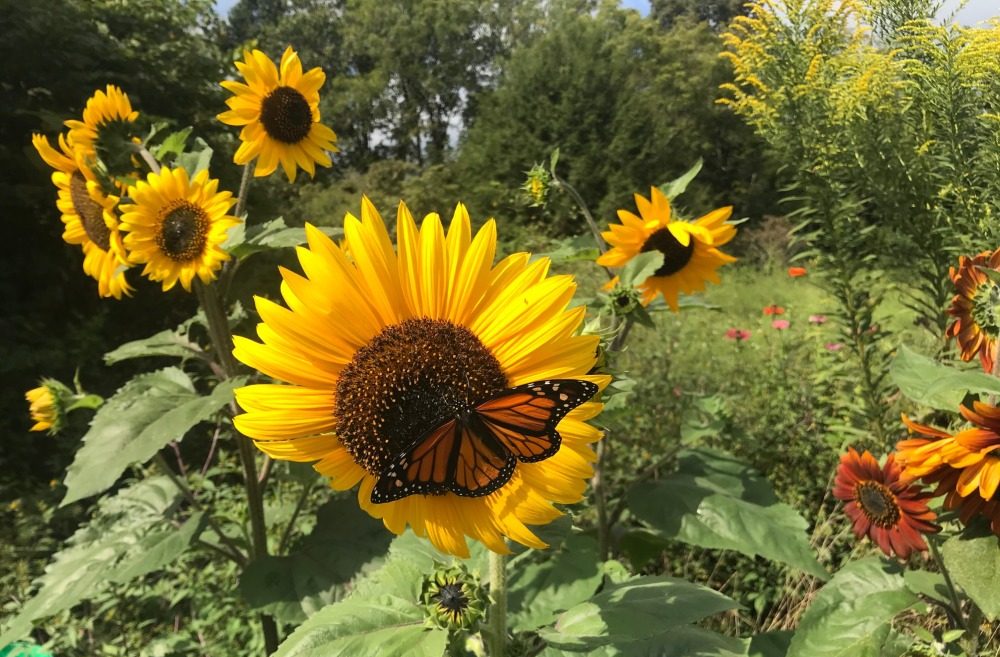Habitat at Home: Growing Milkweed

Growing native milkweed in your yard can create wonderful habitat for all kinds of native insects, especially the monarch butterfly! In fact, monarchs need milkweed to survive. Adult monarchs lay their eggs exclusively on milkweed leaves, nowhere else! In this month’s Habitat at Home we will give you some tips for growing milkweed from seed, so that you might see some monarchs in your backyard.
Learn more: Want to learn more about gardening for butterflies? Check out this full guide to butterfly gardening in Western NC and Upstate SC.
Getting Started!
To make sure you get the best info on how to grow milkweed in your backyard we talked to Kim Bailey, owner of Milkweed Meadows Farm in Fruitland, NC. See Kim’s story. Kim is an expert on all things milkweed and monarch, even supplying local schools with monarch eggs to raise and release. Kim also supplies milkweed seeds to Sow True Seeds – a great place to get native milkweed seeds. Lets get started!
Step 1
Choose your milkweed variety! Sow True Seeds offers a few types, so choose the milkweed that best suits your yard.
Common milkweed – Kim calls this variety exuberant; “It won’t come up in the same spot, but it will pop up a few feet away – with friends!” Because common milkweed tends to spread, it is best for a larger garden or meadow where you don’t mind extra plants popping up. Seeds require cold moist stratification. (See more on that below.)
Swamp milkweed – Swamp milkweed can tolerate extra water, but does well in average soil. This variety is better for smaller gardens and raised beds because it is a perennial and will grow in the same spot each year. Seeds require cold moist stratification.
Butterfly weed – This variety tolerates dry soil the best, making it ideal for raised beds. Butterfly weed is a perennial, and Kim recommends planting this variety somewhere you want it to stay – it can be hard to dig up later. This variety does not require cold moist stratification—seeds can be sown right from the packet!

Step 2
After choosing your variety, figure out the date you want to plant outdoors and back up about 8 weeks to account for stratification and germination. Kim says the saying “don’t plant your tomatoes until after Mother’s Day” holds true for milkweed as well. Aim to plant your ‘baby’ milkweed outside around mid May or later.
Step 3
Cold, moist stratification. This is essential! Cold, moist stratification is essentially tricking your seeds into thinking winter has come and gone. You will do this by placing the seeds in either damp vermiculite or damp paper towel (Kim says these work about the same) and into the refrigerator for about 4 weeks. “The seeds need to experience winter, or they don’t think spring is here yet and they will not germinate,” Kim says. “Typically you will see this called cold stratification, but it needs to be moist, too.”
Step 4
After 4 weeks or more in the fridge, your seeds are ready to sow. If it is later in the season and the chance for frost has passed, you can sow seeds outdoors. If there is still a chance for frost, you can germinate seeds inside and grow using fluorescent or LED lights. Seeds can be grown in most potting soil. Wet the soil and allow it to drain before scattering seeds and covering with about 1/4 inch of soil.
Step 5
When your milkweed has reached 3-6 inches, it is ready to be planted outdoors! Generally, milkweed prefers full sun. Kim suggests planting a patch, but space them out so it is harder for pests to spread.
To show how cold, moist stratification is used to germinate milkweed seeds, Kim wrote an in-depth blog post for Sow True Seed called The Great Milkweed Germination Test. She also gives step by step instructions on how to take your milkweed seeds from “packet to plant”!
The Great Milkweed Germination Test

What’s On My Milkweed?!
You might find some curiosities on your milkweed once it is growing outside. Here’s what they might be:
- Monarch eggs – Monarch eggs are tiny, white, and conical. Monarch butterflies will typically lay 1 egg per milkweed plant, so the caterpillar will have less competition for food as it grows. Can you spot the tiny monarch eggs Kim found on her milkweed?

- Praying mantis ootheca – Ootheca is is just a fancy word for egg sac! These can be off-white to brown and look like a foamy blob on the stem of a plant. Leave these be – praying mantis will eat all kinds of backyard pests!

- Aphids – these clusters of yellow, orange, or green insects look a little bit like insect eggs, but don’t be fooled! Kim says some aphids are fine, but if there are too many you can rinse them off with water.

- Ladybug larvae – These spiked black and red larvae look almost nothing like a lady bug, but that’s what they will become! If you have aphids, hopefully you have these. Ladybugs and their larvae love to eat aphids.

Monarchs Need Fall Blooming Flowers Too!
Learn more: As you plan your garden, don’t forget the monarchs also need fall-blooming nectar plants as they pass through the Carolinas on their fall migration! Here are some tips on how to make sure those beautiful butterflies will find plenty of nectar in your garden.
Interested in improving habitat where you live? We offer seasonal tips on how to make your yard and home a better habitat for native plants, animals, and insects. Explore more Habitat at Home topics here. You can also sign up for Conserving Carolina emails to get the latest Habitat at Home columns in your inbox.
Habitat at Home is a monthly feature dedicated to providing you with tips to make your yard and home a better habitat for native plants, animals, and insects. Written by Kelly Holland.
